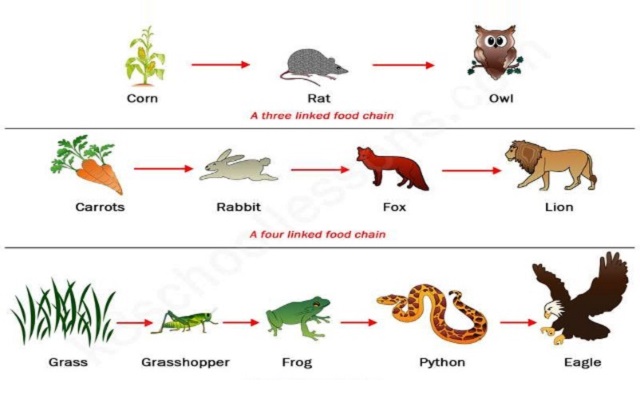Food Chain – Notes On Biology – For W.B.C.S. Examination.
ফুড চেইন – জীববিজ্ঞানের নোট – WBCS পরীক্ষা।
The green plants (autotrophs) synthesize food using solar energy and various inorganic constituents (water, carbon dioxide, etc.) of eco-system. The food manufactured by the green plants is utilised by themselves and also by the herbivores.Continue Reading Food Chain – Notes On Biology – For W.B.C.S. Examination.
The herbivores are consumed by some carnivorous animals. In this way, one form of life is supported by the other form. Thus, food from one trophic level reaches the other trophic level and a chain is established which is known as food chain.
A food chain may be defined as the transfer of energy and nutrients from the source in plants through a series of organisms with repeated processes of eating and being eaten. For example, the marsh vegetation is eaten by the grasshopper the grasshopper is consumed by shrew, the shrew by the marsh hawk or owl.
Thus, a relationship is established:
Marsh grass → Grass hopper → Shrew → Marsh hawk
It is estimated that only about 10 per cent of the potential energy available at the previous trophic level is being available to an organism. The efficiency of a food chain is, therefore, dependent on the number of trophic levels or links in a food chain. The shorter the food chain, the more is the amount of energy available to the last trophic levels in an eco-system.
In all the eco-systems, energy moves as per the direction given below:
Sun → Producer → Consumer → Decomposer
Sun → Autotroph → Heterotroph.
Food chains are of three types:
(a) Grazing or Predator food chain.
(b) Parasitic food chain.
(c) Saprophytic or detritus food chain.
(a) Grazing or Pasturing Food Chain:
This food chain starts from green plants (producers), passes through the herbivore (primary consumers) and ends with carnivore (secondary or tertiary consumers).
The total energy assimilated by green plants is subjected to three important processes:
(i) It may be oxidised in respiration.
(ii) It may die and decay.
(iii) It may be eaten by herbivorous animals.
Like green plants, the disposition of energy in herbivores takes place by either respiration or decay of organic matter by microbes or consumption by carnivore. The primary carnivores eat herbivore and secondary carnivore eat primary carnivore. The total energy in herbivores takes by decay of organic matter by microbes The primary carnivore eat herbivore eat primary carnivore.
The total energy assimilated by primary carnivore is derived entirely from the herbivore and its disposition in to respiration, decay and further consumption by other carnivore is entirely similar to that of herbivore. Thus, the grazing food chain is more effective or efficient as most of the primary production is passed on through different trophic levels and only a small fraction goes to the decomposer system.
A grazing food chain can be described in terms of trophic levels as shown below:
Autotroph→ Herbivore→ Primary Carnivore →Secondary
Carnivore→ Tertiary Carnivore → Decomposer etc.
(b) Parasitic rood chain:
This food chain starts from herbivore but food energy passes from larger to smaller organism without outright killing as in case of predator. Hence, the larger animals are considered to be the hosts and the smaller animals which fulfill their nutritional requirements from the hosts are considered as parasites.
(c) Saprophytic or Detritus Food chain:
In this food chain, the dead organic matter or organic wastes (metabolic wastes and extrudates) of eco-system go to the micro-organisms and finally to detritus feeding organiss known as detrivore. The energy stored in detritus serves as a source of energy for detrivore. This type of food chain is less efficient as the major portion of energy is lost to the eco-system without being properly used.
Food Chain of Different Eco-Systems:
Grassland eco system:
Grass →Grasshopper →Toad→ Snake
Grass→ Rat→ Snake→ Hawk
Grass→ Goat→ Man→ Tiger
Forest eco system:
Plant→ Deer→ Lion
Plant→ Deer→ Tiger
Plant→ Goat→ Tiger
Pond eco-system:
Phytoplankton→ Zooplanktons→ Small fish→ Big fish.
Our own publications are available at our webstore (click here).
For Guidance of WBCS (Exe.) Etc. Preliminary , Main Exam and Interview, Study Mat, Mock Test, Guided by WBCS Gr A Officers , Online and Classroom, Call 9674493673, or mail us at – mailus@wbcsmadeeasy.in
Visit our you tube channel WBCSMadeEasy™ You tube Channel
Please subscribe here to get all future updates on this post/page/category/website



 +919674493673
+919674493673  mailus@wbcsmadeeasy.in
mailus@wbcsmadeeasy.in






































































































